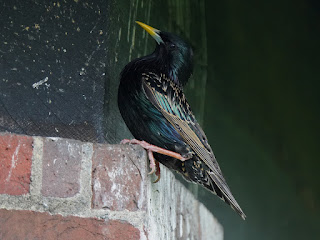The three rescued Canada Goslings could be seen distantly from the Serpentine bridge. When I got round to the edge they had vanished into the waterside bushes where they would be safer.
Strangely, another pair of Canada Geese has now occupied the raft. Will they nest now, and do we have to go through this whole rescue business again?
The Greylags have been bringing out more and more goslings and there may now be as many as 16, though I may have counted one brood of four twice as they are moving around a lot. These four very new ones were amusing themselves by diving.
The first two broods of Coot chicks in the Italian Garden fountains are now old enough to mostly feed themselves, and a bloom of algae brought on by the warm weather gives them plenty of food. There are some of the seven in the southwest pool.
There's now a third Coot family in the fountains, in the northwest pool. The very young chicks climbed around on a net of straw put into the pool to try to stop the growth of algae, though this has had no noticeable effect as you can see from the previous video.
The Coots with five chicks in the northeast pool were building a second nest with waterlily leaves in a crazy place on the edge of the fountain, where the leaves kept getting washed off. When Coots get building mania they are unstoppable.
The Egyptian Geese with four different-sized goslings were near the Triangle. When mother preens, the goslings copy her.
One of the young Grey Herons in the nest at the east end of the island was standing tall in the nest, looking supremely goofy.
The young Lesser Black-Backed Gull that is presumed to be the two-year-old son of Pigeon Eater stood proudly in his father's place on the Dell restaurant roof. He had cleared all the other gulls away from that corner of the lake. His parents are still away (are they nesting somewhere else?), but they will deal with his arrogance when they return.
The female Little Owl at the Serpentine Gallery was in a small lime tree.
A Long-Tailed Tit near the Queen's Temple probed a tree trunk for insects.
Starlings are busy with their nests in the eaves of the Buck Hill shelter.
Vinny got two interesting pictures on Tuesday morning. Two Common Sandpipers were on the edge of the Serpentine in the fenced-off area next to the bridge ...
... and there was a male Reed Bunting. These are quite often seen in the reeds east of the Lido.
I went to the patch of buttercups by the Round Pond to get a better picture of the Fourteen-Spot Ladybird, a difficult creature to photograph because it's so tiny.
The buttercups also provided two different kinds of bee, both I think Andrena Mining Bees ...
... and a Rove Beetle, probably a Tachyporus species, maybe T. hypnorum.
A clump of green alkanet in the Flower Walk had a Seven-Spot Ladybird. A Honeybee landed close by -- there were at least 20 of these here.
But the patch of green alkanet by the bridge, which has been there for years and was a good place for bees of all kinds, has just been destroyed by the gardeners. An ornamental border plant in one place, a despised weed in others.





%20in%20father's%20place%202024%201a.jpg)



%202024%201a.jpg)
%202024%201a.jpg)





Canadas are the embodiment of the English expression "silly goose". Sigh.
ReplyDeleteI don't think I've ever seen such a teeny tiny ladybird before. Haven't seen many two-spot ladybirds lately, either (a Spanish folk name for them is "vaquita de San Antonio", which is the loveliest name)
Tinúviel
Our native ladybirds are being pushed out by invasive Harlequins, so seeing any native species is a pleasure. Incidentally, I wonder what dismal individual called the Harlequin Harmonia axyridis.
DeleteOh, looking it up I see it was the German naturalist Peter Simon Pallas in 1773. The engraving of his face in the Wikipedia article on him makes him look like a complete idiot.